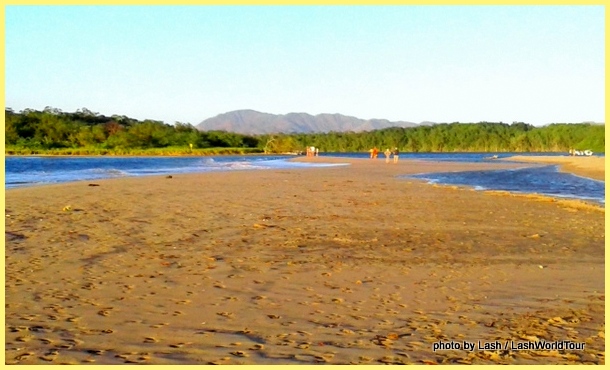
northern end of Tamarindo Beach – costa rica
Beautiful Beaches of Costa Rica’s Pacific Coast
Costa Rica is blessed with a whopping 1254 km / 780 miles of Pacific Coastline. That’s a lot of coast for such a small country. (And that’s not including Costa Rica’s additional 212 km / 132 miles of Caribbean coastline)
For the most part, the long, long Pacific coastline is a hilly forested terrain featuring dozens of beaches set in wide coves that are separated by tapering headlands. There are a few major peninsulas, several huge bays and hundreds of little coves and minor bays.
From the northern border with Nicaragua down to the southern border with Panama, Costa Rica’s Pacific Coast is practically a never-ending series of soft, curving beaches backed almost entirely by trees and dense vegetation. Over 80 major well-known named beaches are eagerly visited by both locals and international travelers. In between those are countless other tiny beaches.
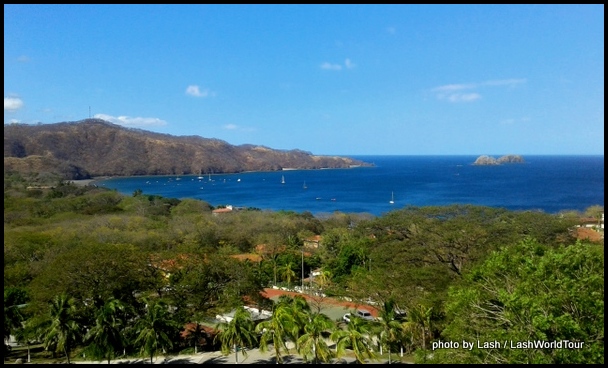
Hermosa Bay – Nicoya Peninsula – Costa Rica
Although these beaches vary slightly in size, width, style of development, type of visitors and ambiance, they are all surprisingly similar. After I visited a few, I noticed a distinctive ‘Costa Rican beach’ type.
Most noticeably, the Pacific Coast beaches feature pale gray volcanic sand. Midday, in the bright, intense sunshine the sand looks practically white. But close to the tide line, where the sand is wet, and at less sunny times of day, it takes on a medium gray tone.
There are some exceptions – a few white-sand beaches – and these tend to be very popular and famous among Costa Ricans, who consider their pale gray sands to look dirty. Examples of white-sand beaches are Playa Conchal in northern Nicoya Peninsula and Manuel Antonio Beach on the central coast.
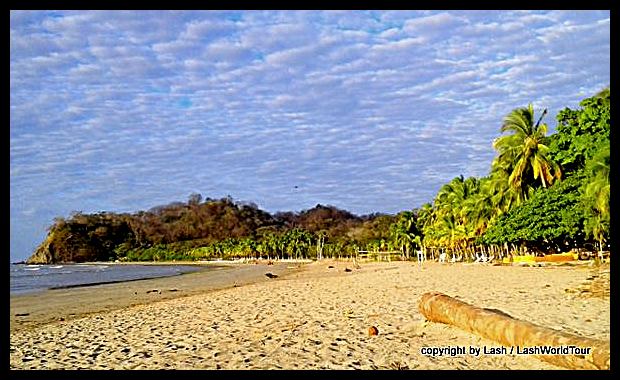 A second distinctive feature is that beaches in Costa Rica tend to be extremely wide, especially at low tide, due to their generally flat slope. They’re also very long, shaped in a gentle curve fitting the bays. As a result, these beaches are very spacious.
A second distinctive feature is that beaches in Costa Rica tend to be extremely wide, especially at low tide, due to their generally flat slope. They’re also very long, shaped in a gentle curve fitting the bays. As a result, these beaches are very spacious.
But the very best thing about Costa Rican beaches is that they all have an ‘au naturale’ look and feel because they’re all backed solely by trees and thick vegetation.
In truth, most beaches do have some development – some combination of small restaurants, bars, petite hotels and/or private homes situated behind them. However, you can barely see these human structures because they are all small 1 or 2-story buildings tucked under the trees. Most are made of natural materials like wood with thatched roofs, so they blend into their surroundings even more.
Amazingly, even Costa Rica’s most developed beaches, like Tamarindo and El Coco, still look au naturale. Rarely will you find a tall cement condo or massive hotel breaking the forest of vegetation lining the back of CR’s beaches.
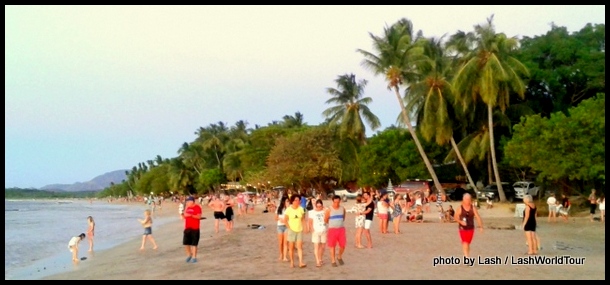
Playa Tamarindo at sunset – one of Costa Rica’s most developed beaches
The biggest difference in the many dozens of beaches lining the country’s long, long coastline is the type of people and development found at each. This is primarily what gives each beach its particular ambiance.
Some, like Playa Samara and remote Playa Montezuma, are more bohemian, with a plethora of yoga, organic and/or vegan restaurants, small boutiqe-chic hotels, groovy clothing and jewelry shops, and live jazz-blues playing at beach-side restaurants in evenings.
A few, like Tamarindo and El Coco, are fairly developed beach-side towns with lots of night life and a huge assortment of restaurants, cafes, shops, tourist offices and… These attract much more mainstream travelers, youth, partiers and people seeking lively vacations.
Many of Costa Rica’s quiet beaches also attract mainstream visitors, where they stay in mid-range hotels, condos and vacation homes. Some places are considerably more upscale, with plush but low-key vacation homes, chic boutique resorts and some of the country’s most expensive, ultra resorts.

Seaside pool at beautiful Secrets Resort on Papagayo Bay
Interestingly, the Pacific Coast also boasts dozens and dozens of luxury hotels, resorts and condos, most of them situated at a beach or up on the hillsides overlooking a beach and bay. Somewhat amazingly, even these rarely disturb the tree-lined au naturale look and feel of the beaches.
In many cases that’s because the resorts consist of low 2 and 3-story buildings, constructed of natural materials. Thatched roofs do an amazing job of blending even large building into their surroundings.
The largest, most famous and most luxurious also tend to be in very remote locations that can only be accessed by private vehicle. They’re generally the only resort in the area, rather than one of a huge cluster of hotels all at one place.
Resorts, condos and private homes that are set up on the hillsides do actually somewhat mar the natural beauty of the given bay, like at Playa Hermosa. But since they’re not situated right behind the beaches, they don’t disturb the natural vegetation backing them and the beaches themselves.
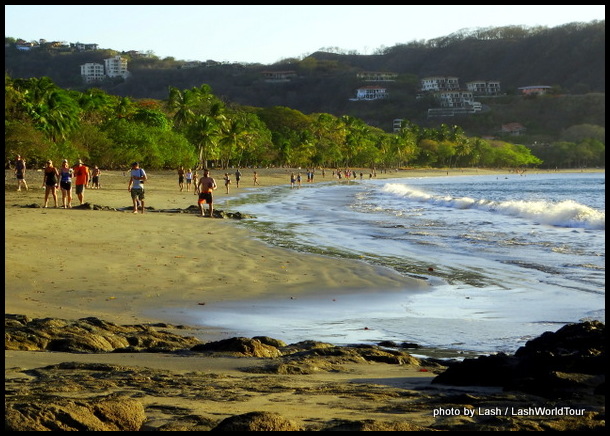
Hermosa Beach – with hillside condos overlooking the bay
Amazingly, Costa Rica has managed to completely avoid horrid over-development of its beautiful beaches. You won’t find anything remotely resembling Waikiki, Hawaii or Kuta Beach, Bali or Phuket, Thailand in Costa Rica! Hip, hip hooray!
Another important feature of Costa Rica’s beaches is that they are all legally public beaches. That means no resort, restaurant or private home owner can block access to the beaches.
This may not always be ideal for guests at luxury hotels who most assuredly would prefer a private beach experience. But guests at the more remote hotels hardly have to worry about a public inundation since the beaches are so hard to reach. At more popular beaches, though, they have to share with the general public.
One great oddity is the ‘beach highways’ of Playa Brasilito, Conchal and Flamingo, three connected beaches. For some inexplicable reason people have become obsessed with driving ON the beaches there, even though it’s technically illegal.
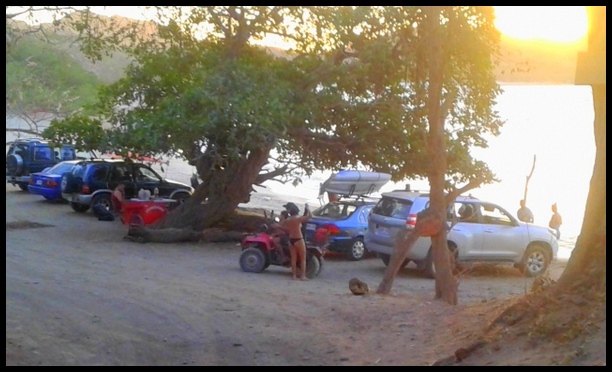
cars parked at Playa Conchal
From early morning until well after dark, these beaches have an unending stream of private cars, motorbikes, ATVs and even large trucks hauling plastic beach chairs!
One explanation I heard is that the only way to access white-sand Conchal Beach is by driving over there from Brasilito Beach. And Costa Ricans are insistent on having public access to their beaches.
Fair enough for the public access. However, it’s a mere 7-minute walk from the beach road entry at Brasilito to Playa Conchal. I walked it myself several times, with cars filing past me. So, uh, sorry, the ‘we must drive to get there’ theory doesn’t hold up.
In any event, the beach highway at these three beaches clearly gives them a very different ambiance and character from other Costa Rican beaches. Thank goodness the other beaches haven’t suffered this fate!
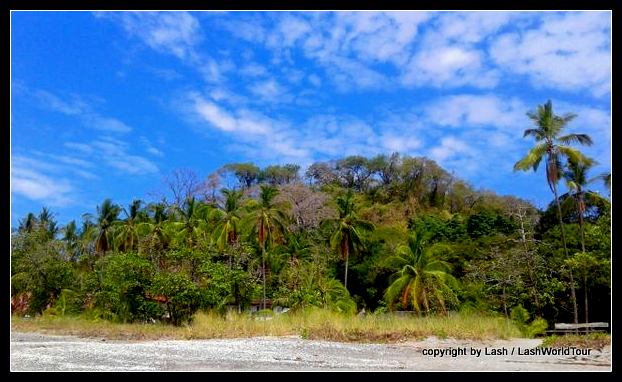
Trees backing Playa Samara
In fact, many beaches are situated within national parks or reserves and therefore have absolutely no development. Nothing behind these beaches but trees and vegetation.
For example, on Nicoya Peninsula, Playa Guiones, just north of Samara, is part of Refugio Nacional de Vida Silvestre Ostional. On the central coast, National Park Manuel Antonio is blessed with the famous white-sand beaches that thousands of international tourists flock to every year.
Most of Costa Rica’s beaches are surfing beaches, some famous among serious surfers. Waves vary tremendously from beach to beach, though, so there are surfing beaches for beginners, novices, advanced and pro surfers.
On the other hand, beaches along the country’s northwestern Nicoya Peninsula are generally calm, better for swimming, snorkeling and diving.
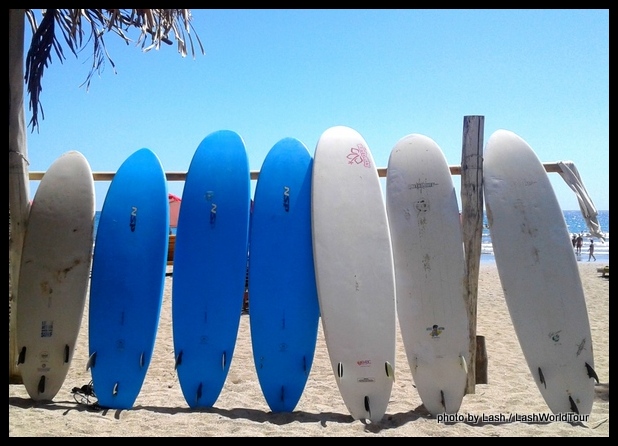
surf boards for rent
One final thing to keep in mind about Costa Rica’s beaches is that the Costa Ricans love spending time at their beaches. It’s wonderful that locals make a point of enjoying their beautiful natural world, but this also means that beaches can get crazy busy, particularly on weekends and holidays.
Anyone seeking a tranquil beach experience had better avoid weekends, Semana Santa (Easter week) and Costa Rica’s long school holiday period from December to mid-February. At these times beaches are usually packed with playful families, couples and large groups of friends & students. It’s bustling!
While Costa Rica is generally believed to be a tropical country, in reality it has two distinct seasons – a dry and a wet season. During dry months, from Nov to May, the climate and vegetation is surprisingly arid. The hills are brown and yellow, filled primarily with bare trees and dry vegetation.
But when the rains hit in early May, everything suddenly becomes very verdant and green. Until Nov or Dec, Costa Rica is all lush, green and tropical.
Oh, yeah – since all of these Pacific Coast beaches are more or less facing west, you’re in for plenty of gorgeous sunsets year-round.
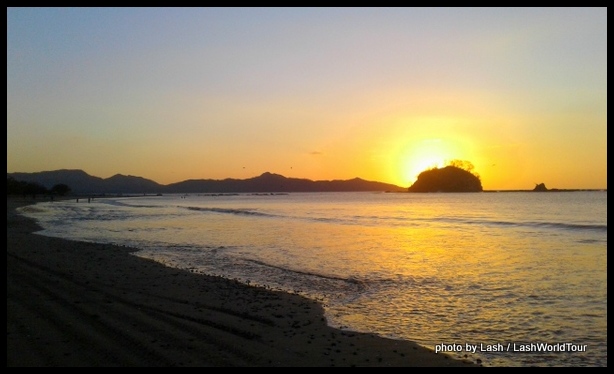
sunset at Brasilito Beach
Summary
Costa Rica has dozens of gorgeous little-developed beaches along its extensive Pacific Coast. While they’re all very similar, they each have a different type of visitor, development ,activities and vibe.
But for anyone seeking those wonderful ‘au naturale’ undeveloped beaches in the world, where the primary experience is of sand, sea, sky and trees, Costa Rica is a great destination. Go read up on the dozens of Pacific Coast beaches, pick ones that sound like you’re kind of place and head down there.
Meanwhile, I’m just getting started on my travels around Costa Rica. I’ll be here another two months, reporting on the great destinations I find and sharing tips and advice along the way. So stay tuned for more on Costa Rica!
In the meantime, you might also like –
Fabulous Samara Beach – Costa Rica
10 Things I Love about Central America
=============================================================









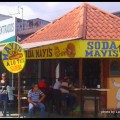


 Hi! I'm Lash, an American nomadic world traveler who's been traveling solo since 1998. I’m passionate about traveling the world nomadically and then sharing it all with you. I hope to inspire you to travel the world, to entertain you with tales from the road, and to help you reach your travel dreams. Welcome!
Hi! I'm Lash, an American nomadic world traveler who's been traveling solo since 1998. I’m passionate about traveling the world nomadically and then sharing it all with you. I hope to inspire you to travel the world, to entertain you with tales from the road, and to help you reach your travel dreams. Welcome! 



